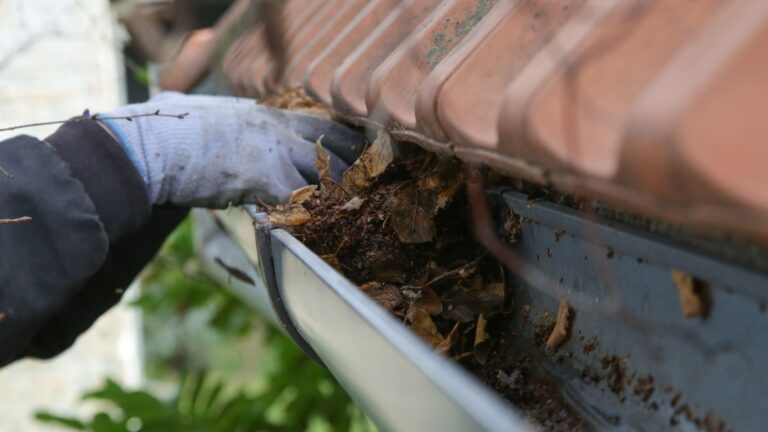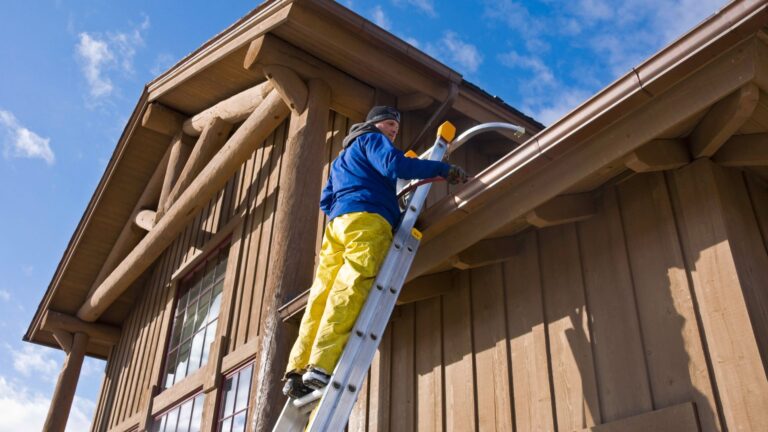Gutter guards are protective coverings or inserts installed over or inside gutters to prevent leaves, twigs, and other debris from clogging the system. Designed to reduce the frequency of manual cleaning and protect against water overflow, these systems come in various styles such as mesh screens, foam inserts, and reverse curve guards. As more homeowners seek low-maintenance solutions, gutter guards have become a popular option for keeping drainage systems functioning smoothly.
In 2025, the rising demand for smart home upgrades and weather-resilient features has driven increased interest in gutter guards. Homeowners are prioritizing convenience, safety, and long-term cost savings—especially in areas prone to heavy rainfall or falling leaves. While gutter guards offer several advantages like reduced upkeep and improved home protection, they also come with limitations such as cost and potential performance issues during extreme weather. This article explores both the benefits and downsides to help you decide if gutter guards are the right solution for your home.
Table of Contents
What Are Gutter Guards and How Do They Work?
Gutter guards are specialized devices designed to block leaves, twigs, and other debris from entering and clogging your gutters while allowing rainwater to flow through freely. They act as a filtration system placed over or inside your existing gutters, drastically reducing the need for frequent cleanings. Gutter guards work by either covering the gutter with a permeable material or guiding water over a curved surface while debris falls away. As homeowners search for smarter drainage solutions, understanding how these systems function is essential to choosing the right one for your property.
There are several types of gutter guards available on the market, each offering distinct features, benefits, and installation methods. Here’s a quick overview of the types of gutter guards explained:
- Mesh Gutter Guards: Fine metal or plastic screens that block small debris while letting water pass through.
- Foam Gutter Guards: Porous foam inserts placed inside gutters to block debris from entering.
- Brush Gutter Guards: Cylindrical bristle brushes that sit inside the gutter, trapping leaves on top while water flows beneath.
- Reverse Curve (Surface Tension) Guards: Curved covers that direct rainwater into the gutter while pushing debris off the edge.
- Screen Gutter Guards: Simple metal or plastic screens that snap onto gutters; more affordable but less durable than mesh.
Choosing the right type depends on your local environment, roof type, and budget—each has its own advantages and maintenance requirements.
Do Gutter Guards Really Work? The Truth Behind the Hype
Gutter guard manufacturers often promise a near-maintenance-free solution, claiming their products completely eliminate the need for gutter cleaning. While it’s true that many gutter guards significantly reduce debris buildup, real-world performance can vary depending on factors like the type of guard, the volume of falling debris in your area, and installation quality. In many cases, guards do help extend the time between cleanings and prevent serious clogs, but they don’t entirely eliminate maintenance needs—especially during heavy storm seasons or in areas with dense foliage.
A common misconception is that gutter guards make gutters completely immune to blockages. The reality is more nuanced. While most systems are effective at deflecting large leaves and twigs, smaller particles like pine needles, seed pods, and shingle grit may still find their way through—particularly in lower-quality or poorly fitted models. So, do gutter guards stop leaves and debris? Yes, to a significant extent—but not 100%. Understanding this balance between marketing claims and actual performance helps homeowners make smarter, expectation-aligned decisions when investing in these products.
Minimize Gutter Cleaning Costs
One of the most immediate and noticeable benefits of installing gutter guards is the reduction in regular cleaning expenses. Without a guard system, gutters typically require cleaning at least twice a year—or more frequently in areas with heavy foliage. Hiring professionals for this job can cost hundreds annually, and even DIY cleaning involves time, effort, and potential safety risks. Gutter guards reduce the accumulation of debris, meaning fewer cleanings are necessary and less money spent on maintenance over time.
Although gutter guards come with an upfront cost, they can pay for themselves in a few short years by significantly lowering the need for professional services. Additionally, reducing the frequency of cleaning minimizes wear and tear on your gutters, potentially extending their lifespan and delaying repairs or replacements. In this way, investing in gutter guards is not just about convenience—it’s a practical, long-term strategy to minimize gutter cleaning costs while maintaining your home’s exterior integrity.
Enhance Roof and Foundation Protection
Gutter guards do more than just keep your gutters clean—they play a crucial role in protecting your roof and foundation from potential damage. When gutters become clogged with leaves and debris, water can overflow and accumulate near your roofline. This not only increases the risk of water damage to your roofing materials but can also lead to the growth of mold, mildew, and algae, which degrade your roof’s integrity over time. Gutter guards prevent this overflow by ensuring that water flows smoothly through the gutters, reducing the risk of costly roof repairs and premature aging.
Additionally, clogged gutters can lead to water pooling around your home’s foundation. When this happens, excess moisture can seep into the soil, causing soil erosion, foundation cracks, and even basement flooding. By keeping gutters clear and promoting effective water drainage, gutter guards help divert water away from your home’s foundation, enhancing its protection and preventing long-term structural damage. With gutter guards in place, homeowners gain peace of mind knowing that their roof and foundation are better safeguarded from the elements.
Common Problems and Limitations of Gutter Guards
While gutter guards can significantly reduce frequent cleaning, they are not without their drawbacks. One of the most common issues homeowners experience is overflow during heavy rain. In areas with heavy rainfall or intense storms, even the best gutter guard systems may struggle to handle large volumes of water. If the guards are not properly designed to handle extreme conditions, or if they become clogged with smaller debris like pine needles, water may overflow, causing damage to the roof, fascia, or foundation. This is often a key source of gutter guard complaints, particularly in regions with unpredictable weather patterns.
Another limitation of gutter guards stems from improper installation. Even the highest-quality gutter guards can underperform if they’re not installed correctly. Incorrect fitting can lead to gaps, misalignment, or debris buildup in certain areas, all of which hinder the system’s effectiveness. Homeowners who opt for DIY installations may face frustration, as poorly installed guards fail to provide the expected benefits. Hiring a professional to install gutter guards can often help avoid these issues, but it does come with an additional cost. Proper installation is key to ensuring that gutter guards live up to their promises and minimize potential problems.
Cost vs. Value: Are Gutter Guards Worth It?
Type of Gutter Guard | Average Cost (Per Linear Foot) | Installation Method | Durability | Maintenance Needed | Long-Term ROI | Value Summary |
Mesh Guards | $1.50 – $4.00 | Professional or DIY | High | Low | High | Excellent cost-effective gutter protection with minimal upkeep. |
Foam Inserts | $0.90 – $2.50 | DIY | Low to Medium | Moderate | Moderate | Cheap up front, but may need replacement sooner. |
Brush Guards | $1.25 – $3.00 | DIY | Medium | High | Low to Moderate | Easy to install, but requires frequent cleaning. |
Reverse Curve Guards | $3.00 – $7.00 | Professional recommended | High | Low | High | Great protection, higher cost, strong long-term savings. |
Screen Guards | $0.50 – $1.75 | DIY or Professional | Low to Medium | Moderate | Moderate | Budget-friendly option, but less effective in heavy debris areas. |
How Gutter Guards Compare to Traditional Gutter Maintenance
Aspect | Traditional Gutter Maintenance | Gutter Guards (Permanent Solution) |
Cleaning Frequency | 2–4 times per year, especially in fall and spring | 1–2 times per year (minor debris check) |
Cost Over Time | Ongoing costs for professional cleaning or tools | One-time investment with long-term savings |
Time Investment | High – requires several hours per cleaning session | Low – minimal upkeep once installed |
Safety Risk | High – climbing ladders poses fall hazards | Low – significantly reduces the need for ladder use |
Effectiveness | 100% effective if done properly and frequently | 85–95% effective depending on type and quality of guard |
Best For | Homes with minimal foliage or tight budgets | Homes in wooded areas or those seeking low-maintenance living |
Expert Tip | Use downspout guards and inspect during rainy seasons | Choose professionally installed mesh guards for best results |
SEO Tip | Read more gutter maintenance tips for seasonal care | Explore gutter maintenance tips to get the most from your system |
Professional Installation vs. DIY: Which is Better?
Pros of Professional Installation
- Expert assessment ensures correct product selection for your roof type.
- Proper alignment and secure attachment minimize long-term issues.
- Often comes with warranties or service guarantees.
- Ideal for multi-story homes or difficult rooflines.
Cons of Professional Installation
- Higher upfront cost compared to DIY.
- Scheduling and availability can delay the project.
- Limited customization unless discussed in advance.
Pros of DIY Gutter Guard Installation
- Cost-effective solution for budget-conscious homeowners.
- Flexible timing—install at your own pace.
- Great for smaller, single-story homes with safe roof access.
- Many products are now designed for easy snap-on or slide-in use.
Cons of DIY Gutter Guard Installation
- Risk of improper installation, reducing effectiveness.
- May not fully secure guards, leading to debris buildup or detachment.
- Potential safety risks without proper equipment or experience.
Common DIY Mistakes to Avoid
- Choosing the wrong type of guard for your roof or gutter style.
- Leaving gaps between guard sections.
- Overlooking corners or downspout entrances.
- Failing to clean gutters thoroughly before installation.
- Ignoring slope and water flow direction.
Conclusion: Should You Invest in Gutter Guards?
These guards can be a smart investment for homeowners seeking to reduce maintenance, improve water flow, and protect their home from costly damage—but they’re not a one-size-fits-all solution. While they offer clear benefits such as preventing clogged gutters, minimizing cleaning costs, and enhancing safety, their effectiveness largely depends on the type, installation quality, and surrounding environment. If your home is in a heavily wooded area or prefers a low-maintenance lifestyle, gutter guards may offer strong long-term value. However, those on a tight budget or in low-debris zones might find traditional maintenance more cost-effective. To make the best decision, it’s wise to consult a local gutter expert who understands your home’s specific needs and climate challenges.






